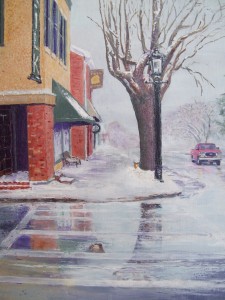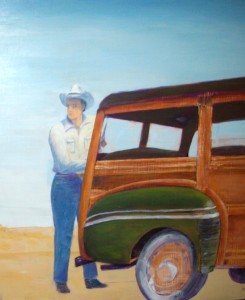
I’m sure most of us artist prefer painting a complicated outdoor scene in the soft illumination of a cloud covered sky rather than the extreme contrasts of light and shadow caused by the bright sunlight of a cloudless day. It is so much simpler without the sharp shadows complicating the scene since the forms are in their true colors without striking contrasts of bright to dark.
I’ve often been pleased to note that the colors tend to be more pure–you might even say, brighter–than they do in dappling sunlight.
For example, in the process of painting the “Old Woodie,” I’ve had to spend more time concentrating on the proper color mix and the effects of shadow and the decision to use my artistic license when deciding to show contrast. I haven’t even gotten to hard decision of the value the shadow will cause that is naturally beneath the car. If I do not do it correct, it could change the value of all the other shadows in the picture. The sun is coming in about 1:00 p.m. and the shadow is on sand.

For the sake of discussion, ignore the unfinished portion of the tires, and concentrate on the unpainted shadow beneath the car and behind the man. If you have read some of my earlier blogs I made mention this painting came from a small black and white photograph taken sometime between 1948 and 1950. The man in the picture is my father filling up “Old Woodie”, a nickname we gave the car.
My dilemma is that the photograph and the full sized pencil drawing I made of this picture has the values too extreme and contrasting, and it would not be anything that would work in this painting the way I decided to paint it. So, I chose to soften the contrast. I’ve taken photos of a 1:00 sun and a model with a western hat and shadows beneath a car and it isn’t near the contrast as the old black and white photograph.
